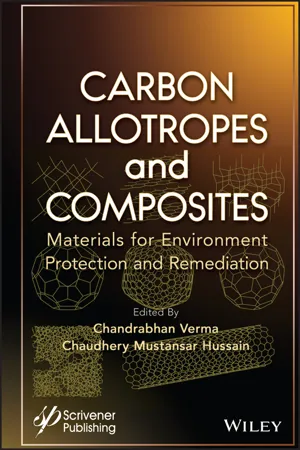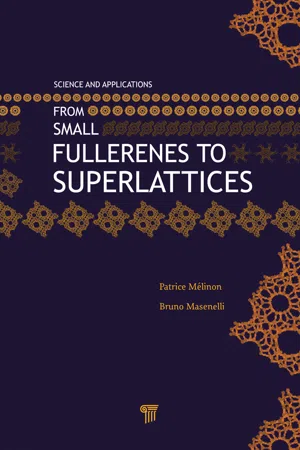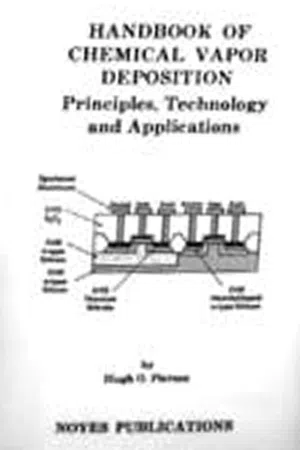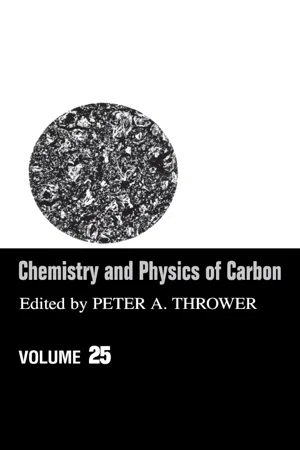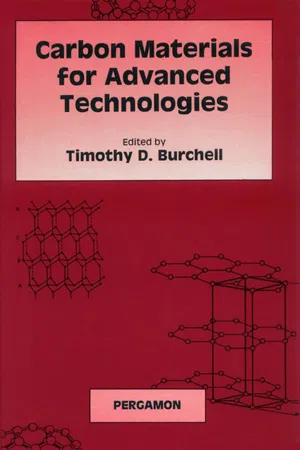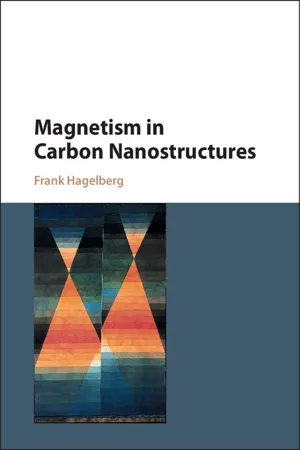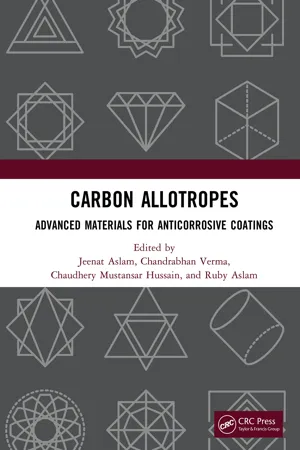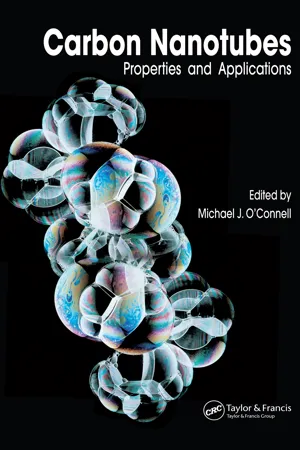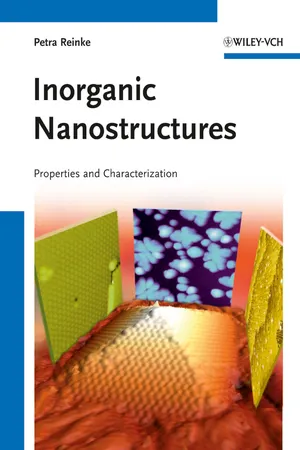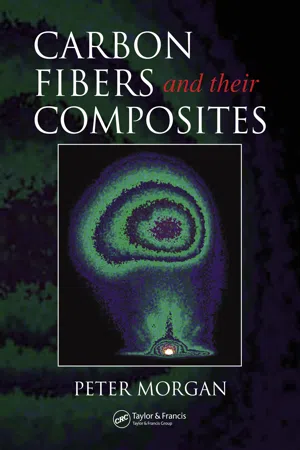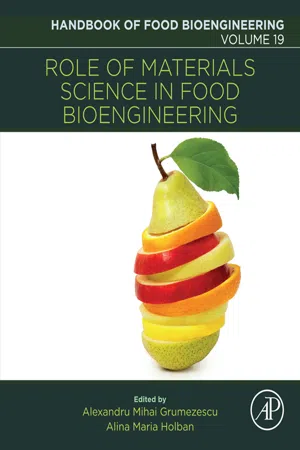Chemistry
Allotropes of Carbon
Allotropes of carbon are different forms of carbon that exist in the same physical state but have different chemical structures. Some well-known allotropes of carbon include diamond, graphite, and graphene. Each allotrope has unique properties and uses, such as diamond's hardness, graphite's conductivity, and graphene's strength and flexibility. These allotropes play a significant role in various industrial and technological applications.
Written by Perlego with AI-assistance
Related key terms
1 of 5
12 Key excerpts on "Allotropes of Carbon"
- eBook - ePub
Carbon Allotropes and Composites
Materials for Environment Protection and Remediation
- Chandrabhan Verma, Chaudhery Mustansar Hussain(Authors)
- 2023(Publication Date)
- Wiley-Scrivener(Publisher)
[9] . When one carbon atom joins with another carbon atom, covalent bonds are created. Allotropes are chemically similar elements with radically different physical characteristics to make this phenomenon easier to explain. As a result, an allotrope is created if the atoms of a material that solely contains one kind of atom are arranged differently. Because of this, several other carbon allotropes and forms, including graphene, buckminsterfullerene, carbon nanotubes, etc., were found, making carbon the material with the greatest number of allotropes that have been detected.Structures of several 0-, 1-, 2-, and 3-dimensional carbon nanomaterials showing sp2 and sp3 hybridization allotropes in various crystallographic forms [10] .Figure 3.1Reproduced from Ref. [10] , [https://doi.org/10.3390/ma8063068 ], under the terms of the CC BY 4.0 license.3.1.1.1 Graphite
The crystalline form of the element carbon is called graphite. Graphene is arranged in layered layers throughout. The most stable form of carbon under normal circumstances is graphite, which occurs naturally. Due to in-plane metallic bonding, which makes it an excellent electrical and thermal conductor inside the layers and a poor conductor perpendicular to the layers, graphite is anisotropic (because the van der Waals forces between the layers are weak) [11] . Within each layer of graphite’s layer structure, the atoms are organized in a hexagonal arrangement, and the layers are layered in the AB pattern. As a consequence, the hexagonal unit cell has the following measurements: c = 6.71 A˚ and a = 2.46 A˚. Carbon sheets with trigonal planar structures make up graphite. Graphene is the name of the individual layers. Each layer’s carbon atoms are organized in a honeycomb lattice with 0.142-nm-long bonds and 0.335-nm-wide gaps between the planes. The comparatively weak van der Waals connections and frequent gas vacancies in the layer bonds enable the graphene-like sheets to glide past one another and be readily separated [12] - eBook - PDF
From Small Fullerenes to Superlattices
Science and Applications
- Patrice Melinon, Bruno Masenelli, Patrice Melinon, Bruno Masenelli(Authors)
- 2012(Publication Date)
- Jenny Stanford Publishing(Publisher)
Figure 2.1 shows as examples the elementary molecules corresponding to the three bonding schemes. 2.1.2 Allotropic Forms Using the previously mentioned bonding schemes, a huge variety of allotropic phases can be imagined. However, the Allotropes of Carbon are not clearly defined in the literature. Some authors try to provide an exhaustive list including, graphite, diamond, fullerene, onion, amorphous carbon, glassy, nanotubes . ... The validity of such an approach could be questioned since the list of complex architectures is far from being complete. We therefore adopt a more restrictive definition for the allotropic forms that obey the following criteria: • a long range order in 1D, 2D or 3D space (crystal). • the network is enough stable to be observed in normal conditions • the hybridization is 1 ( sp ), 2 ( sp 2 ), or 3 ( sp 3 ). In other words, mixed hybridized states are discarded. Beside the wide occurrence of carbon in compounds, strictly speaking, two allotropes of the element (diamond, including cubic and hexagonal, and graphite, including hexagonal and rhombohe-dral) are reported. Other forms are not stable, either predicted by theory or just observed at high pressure and high temperature. 10 Carbon Properties Figure 2.1. Elementary molecules corresponding to the three possible types of bonding. Acetylene C 2 H 2 ( sp bonding), ethylene C 2 H 4 ( sp 2 bonding) and ethane C 2 H 6 ( sp 3 bonding). In the sp bonding two geometries can be distinguished with a triple bond (acetylene C 4 H 2 ) or two double bonds (allene C 3 H 4 ). - eBook - PDF
Handbook of Chemical Vapor Deposition
Principles, Technology and Applications
- Hugh O. Pierson(Author)
- 1999(Publication Date)
- William Andrew(Publisher)
The CVD of the Allotropes of Carbon 185 7 The CVD of the Allotropes of Carbon 1.0 THE Allotropes of Carbon The carbon atom has four valence electrons and four vacan-cies in its outer shell with a ground state electron configuration of 1s 2 2s 2 2p 2 . Such a configuration allows the ready formation of several allotropic forms: graphite, microcrystalline carbon, diamond, lonsdaleite (a form detected in meteorites), and the recently discov-ered 60-atom (or more) carbon spherical molecule, the so-called fullerenes. [1] These allotropes (or polymorphs) have the same build-ing block, the carbon atom, but their physical form – the way the building blocks are put together, i.e., their crystalline structure – is different. Carbon is unique among all the elements in the number and the variety of its allotropes. This chapter is a review of the two major allotropes: graphite and diamond, which are both produced extensively by CVD. The properties of these two materials can vary widely. For instance, diamond is by far the hardest-known material, while graphite can be one of the softest. Diamond is transparent to the visible spectrum, while graphite is opaque; diamond is an electrical insulator, while graphite is a conductor. 185 186 Handbook of Chemical Vapor Deposition 2.0 THE CVD OF GRAPHITE 2.1 Structure of Graphite The structure of graphite is shown in Fig. 7.1. The carbon atoms form continuous hexagons in stacked basal planes (ab direc-tion). Within each basal plane, the carbon atom is strongly bonded to its three neighbors with a covalent bond, having a bond strength of 524 KJ/mol. This atomic bonding is threefold coordinated and is known as sp 2 . The hybridized fourth valence electron is bonded to an electron of the adjacent plane by a much weaker metallic-like bond of only 7 KJ/mol. The spacing between basal planes (0.335 nm) is larger than the spacing between atoms in the plane (0.142 nm). - eBook - PDF
Chemistry & Physics of Carbon
Volume 25
- Peter A. Thrower(Author)
- 1996(Publication Date)
- CRC Press(Publisher)
Currently, all forms of amorphous carbon (various carbon blacks, soots, cokes, etc.) are assigned to the so-called transitional forms of carbon [2], whose structure approaches that of graphite to various degrees. Recently, a family of spherical carbon molecules (called fullerenes) was discovered and was set apart by researchers as an independent allotropic form of carbon [3]. Thus, in how many allotropic forms can elemental carbon exist, and what is the criterion to distinguish them from the multitude of carbon materials? The most convenient and correct classification scheme for carbon materials is their division according to the type of chemical bonds [4], i.e., according to the type of hybridization of the valence orbit-als (Fig. 1). It is well known that carbon can exist in three valence states, which correspond to sp 3 -, sp 2 -, and sp-hybridization of the atomic orbitals. According to the classification mentioned above, there are three pure carbon allotropes corresponding to each valence state. The first state (sp 3 ) corresponds to the three-dimensional (spatial) polymer of carbon, dia-mond. The second state (sp 2 ) corresponds to the two-dimensional (planar) polymer of carbon, graphite. Finally, the third valence state (sp) corre-sponds to the one-dimensional (chainlike) polymer called carbyne. Notice that this classification is closely related to a very illustrative scheme devel-oped recently for carbon materials by Heimann et al. [5]. Each of three carbon allotropes mentioned reveals the polymorphism property [1]. Diamond exists as a cubic form (CIII), hexagonal form (also called CIV, lonsdaleite, 8-phase, diamond polytype 2H), and the diamond polytypes 8H, 12H, 16H, 20H. Graphite exists as the hexagonal form (also called CI, a-graphite, graphite polytype 2H), rhombohedral form (also Carbyne-A Linear Chalnlike Carbon Allotrope DIAMOND HEXAOONAL CC IV, LONSDALEITE) MIXED CARBON FORMS AMORPHOUS CARBON VITREOUS CARBON CARBON BLACkS, etc. - eBook - PDF
Carbon Nanomaterials
Synthesis, Structure, Properties and Applications
- Rakesh Behari Mathur, Bhanu Pratap Singh, Shailaja Pande(Authors)
- 2016(Publication Date)
- Taylor & Francis(Publisher)
1 1 Introduction to Carbon and Carbon Nanomaterials 1.1 Introduction Carbon is the fifteenth most abundant element in the earth’s crust, and the fourth most abundant element in the universe by mass after hydrogen, helium, and oxygen. Carbon is also present as a major component in large masses of carbonate rocks, including limestone, dolomite, and marble. Coal is the largest commercial source of mineral carbon, accounting for nearly 8 billion tons or almost 80% of fossil carbon fuel. In its elemental form, carbon (C, atomic number 6) has a valency of 4 and is therefore placed in group IV of the periodic table along with Si, Ge, Sn, and Pb. Carbon can exist in both crystalline and amorphous forms. Figure 1.1 shows the three crystalline Allotropes of Carbon, that is, with same chemical properties but with different physical forms. All carbon allotropes are solids under normal conditions, with graphite being the most thermodynamically stable form. In reality all the allotropes of amorphous carbons are made of microcrystals of graphite arranged in an irregular fashion. Diamond, graphite, and fullerenes are crystalline Allotropes of Carbon. The carbon atoms in diamond have a three-dimensional (3D) tetrahedral network of covalent bonds, which causes the electrons to be held tightly. Diamonds are therefore very hard and have high melting and boiling points. The structure is a closely packed structure and causes diamond to be denser than graphite. Since all its electrons end up in forming the covalent bonds, therefore it does not conduct electricity. In graphite only three of the four valence electrons of each carbon atom are used in bonding, leaving the fourth valence electron as free. Therefore graphite is a good conductor of electricity. Diamond is transparent because it has no free electron to absorb radiations and make a transition in the optical region. - eBook - ePub
- T.D. Burchell(Author)
- 1999(Publication Date)
- Elsevier Science(Publisher)
Table 2 lists some values of carbon-carbon bond lengths obtained from crystals of organic compounds. In general, bond length decreases as the bond order of adjacent carbon-carbon bonds increases.Table 1 Some properties of carbon-carbon bondsTable 2Carbon-carbon bond lengths in organic compounds [2 ].Carbon-carbon bond Sub-structure Bond length/pm Single bonds ↓a Csp3 -Csp3 -C* -C* - 153.0b Csp3 -Car -C* -Car 151.3b Csp3 -Csp2 -C* -C=C- 150.7b Csp3 -Csp1 -C* -C=C- 149.0 Csp2 -Car C=C-Car 148.3b Csp2 -Csp2 C=C-C=C 146.0b Csp2 -Csp1 C=C-C≡C 143.1 Multiple bonds Car Car (phenyl) C* -C C-C* 139.7b Csp2 =Csp2 C* -C=C-C* 131.6 Csp1 ≡Csp1 C* -C≡C-C* 118.1b a points to the relevant carbon-carbon bondb overall value2 Crystalline Forms of Carbon
The commonest crystalline forms of carbon, cubic diamond and hexagonal graphite, are classical examples of allotropy that are found in every chemistry textbook. Both diamond and graphite also exist in two minor crystallographic forms: hexagonal diamond and rhombohedral graphite. To these must be added carbynes and Fullerenes, both of which are crystalline carbon forms. Fullerenes are sometimes referred to as the third allotrope of carbon. However, since Fullerenes were discovered more recently than carbynes, they are chronologically the fourth crystalline allotrope of carbon. Crystalline Fullerenes are now commercially-available chemicals and their crystal structures and properties have been extensively studied. By contrast, convenient methods for mass production of pure carbynes have not yet been discovered. Consequently, carbynes have not been as extensively characterised as other forms of carbon. The structures and chemical bonding of these crystalline forms of carbon are reviewed in this section.2.1 Diamond
Diamond is an important commodity as a gemstone and as an industrial material and there are several excellent monographs on the science and technology of this material [3 –5 ]. Diamond is most frequently found in a cubic form in which each carbon atom is linked to four other carbon atoms by sp3 σ bonds in a strain-free tetrahedral array, Fig. 2A . The crystal structure is zinc blende type and the C-C bond length is 154 pm. Diamond also exists in an hexagonal form (Lonsdaleite) with a wurtzite crystal structure and a C-C bond length of 152 pm. The crystal density of both types of diamond is 3.52 g·cm−3 - eBook - PDF
- Frank Hagelberg(Author)
- 2017(Publication Date)
- Cambridge University Press(Publisher)
Part II Carbon and Its Nanoscale Allotropes 4 Graphene In this chapter, as well as the following two, we present the structural protoypes of carbon nanosystems, namely graphene, carbon nanotubes and fullerenes. These represent nanoscopic Allotropes of Carbon in two, one and zero dimensions. With respect to the dimensionality and also to the chronology of carbon nanostruc- ture research, Chapters 4 to 6 of this text go in reverse order. The reason for this choice is the fundamental significance of graphene for intrinsic magnetism in carbon-based materials. Besides providing general information about graphene, this chapter introduces the dimensionally reduced graphene nanoribbons. The zigzag types of these species have been shown to display magnetism in their ground state and may be understood as the basic units of carbon nanostructure magnetism. In elemental carbon, four valence electrons occupy the 2s and 2 p x / p y orbitals, yielding the occupation scheme 1s 2 , 2s 2 , 2 p 2 for the electronic shell of the car- bon atom. The ground state of the carbon atom is, in spectroscopic notation, 3 P 0 , involving a spin triplet in conjunction with a total orbital angular momentum L = 1, and a total angular momentum J = 0. This configuration confines carbon to two chemical bonds only, as exemplified by the carbene CH 2 . Carbon compounds, however, usually involve three or four bonds. This is achieved by promoting a 2s electron into a 2 p orbital, which leads to the formation of hybridized molecular orbitals. We distinguish between sp, sp 2 and sp 3 hybridization. In these cases, the 2s and two 2 p orbitals combine, giving rise to two (sp), three (sp 2 ) or four (sp 3 ) mixed s - p orbitals, as represented by linear combinations of atomic orbitals of s and p character. In the regime of carbon-based molecules and polymers, examples for these hybridization schemes are provided by acetylene (the sp case), poly- acetylene (sp 2 ), and methane (sp 3 ). - eBook - ePub
Carbon Allotropes
Advanced Materials for Anticorrosive Coatings
- Jeenat Aslam, Chandrabhan Verma, Chaudhery Mustansar Hussain, Ruby Aslam, Jeenat Aslam, Chandrabhan Verma, Chaudhery Mustansar Hussain, Ruby Aslam(Authors)
- 2023(Publication Date)
- CRC Press(Publisher)
38 ].4.3 Synthesis and Characterization of Carbon AllotropesThere is no disputing that carbon nanomaterials offer intriguing properties that have insured their employment in numerous applications. However, structural variability and imprecise manufacturing brought on by the synthesis process have made it highly challenging to utilize these materials in a variety of applications. But since new synthesis methods have been developed and current ones are continually improved, large quantities of high-quality carbon-based nanomaterials have been produced while using less time and energy. Depending on how the carbon atoms are positioned adjacent to one another, they may produce compounds with a variety of properties due to their allotropic features. The classification of carbon allotropes can be done using their morphological characteristics. These carbon allotropes’ atomic arrangements and interactions with other substances have a big impact on how they behave. In terms of their optical, electrical, mechanical, and surface area-to-volume ratio properties, carbon-based nanomaterials outperform conventional materials. Carbon allotropes have been characterized using several spectroscopic and spectrometric techniques that are often used in organic chemistry, including UV-vis, NMR, FTIR, Raman, and mass spectrometry. For instance, among other techniques, fullerenes have been produced by arc discharge, chemical vapor deposition (CVD), and laser ablation [42 ]. CNTs have been produced via arc discharge [43 ], laser ablation [44 ], CVD [45 ], solid-state pyrolysis [46 ], plasma torch [47 ], and liquid electrolysis [48 ]. A diagram of the CVD synthesis process is presented in Figure 4.6 . Graphene has been produced by exfoliation [48 ], CVD [49 ], arc discharge [50 ], laser ablation (pulsed laser deposition) [51 ], unzipping of CNTs [52 ], Hummer's method [53 ], and chemical-based techniques [54 - eBook - ePub
Carbon Nanotubes
Properties and Applications
- Michael J. O’Connell, Michael J. O'Connell(Authors)
- 2018(Publication Date)
- CRC Press(Publisher)
chapter one The element carbon Frank HennrichInstitut für NanotechnologieCandace ChanStanford UniversityValerie MooreRice UniversityMarco RolandiStanford UniversityMike O’ConnelTheranos, Inc.Contents1.1 Allotropes of Carbon 1.2 History 1.3 Structure 1.4 Progress of single-walled carbon nanotube research References Carbon is the most versatile element in the periodic table, owing to the type, strength, and number of bonds it can form with many different elements. The diversity of bonds and their corresponding geometries enable the existence of structural isomers, geometric isomers, and enantiomers. These are found in large, complex, and diverse structures and allow for an endless variety of organic molecules.The properties of carbon are a direct consequence of the arrangement of electrons around the nucleus of the atom. There are six electrons in a carbon atom, shared evenly between the 1s, 2s, and 2p orbitals. Since the 2p atomic orbitals can hold up to six electrons, carbon can make up to four bonds; however, the valence electrons, involved in chemical bonding, occupy both the 2s and 2p orbitals.Covalent bonds are formed by promotion of the 2s electrons to one or more 2p orbitals; the resulting hybridized orbitals are the sum of the original orbitals. Depending on how many p orbitals are involved, this can happen in three different ways. In the first type of hybridization, the 2s orbital pairs with one of the 2p orbitals, forming two hybridized sp1 orbitals in a linear geometry, separated by an angle of 180°. The second type of hybridization involves the 2s orbital hybridizing with two 2p orbitals; as a result, three sp2 orbitals are formed. These are on the same plane separated by an angle of 120°. In the third hybridization, one 2s orbital hybridizes with the three 2p orbitals, yielding four sp3 orbitals separated by an angle of 109.5°. Sp3 - eBook - ePub
Inorganic Nanostructures
Properties and Characterization
- Petra Reinke(Author)
- 2012(Publication Date)
- Wiley-VCH(Publisher)
Chapter 6 Pure Carbon Materials 6.1 Carbonaceous Materials and BondingThe unique structural versatility of carbon is based on its ability to adopt three different states of hybridization, namely sp1 , sp2 , and sp3 , which determine the local geometric arrangement around the carbon atom. The free carbon atom has an atomic orbital ground state configuration of 1s2 2s2 2p2 but since the stability of a chemical bond can be directly related to the overlap of electronic orbitals participating in the bond, it is favorable to maximize the overlap through hybridization of the 2s and 2p orbitals. The hybridization constitutes an excited state in the free atom and only becomes favorable upon bond formation. The type of hybridization determines the connectivity of the resultant structure, where the directionality in bonding is provided by the formation of covalent bonds. While the sp1 hybridization allows the formation of linear chains and triple bonds between the atoms (two π- and one σ-bond), sp2 hybridization leads to the formation of two-dimensional (2D) graphene sheets with a local trigonal-planar bonding environment and double bonds between the carbon atoms (one π- and one σ-bond). A three-dimensional (3D) network can be formed from sp3 -hybridized, tetrahedrally coordinated carbon atoms and is the basis of diamond, the hardest material known to date. In addition to the covalently bonded networks, van der Waals forces between single graphene sheets and the deviation from the perfectly planar graphene geometry yields π-bonded materials, such as fullerenes, carbon nanotubes and graphene, which have revolutionized nanoscience.Graphite and diamond occur naturally and under ambient conditions graphite is the thermodynamically stable phase [303]. Although cubic diamond is the most well-known allotrope, hexagonal diamond (Lonsdaleite) has been reported as a high pressure phase, and has been found in meteorites [304, 305]. The same holds true for graphite, which is usually found in a hexagonal lattice but a different stacking of the graphene sheets can lead to a rhombohedral symmetry [306, 307]. The structural diversity of pure carbon materials is not limited to the crystalline phases and also includes amorphous structures, with varying contributions of sp3 - and sp2 -hybridized carbon atoms (the sp1 - eBook - PDF
- Peter Morgan(Author)
- 2005(Publication Date)
- CRC Press(Publisher)
2.11.3 Hyperfullerenes In 1992, Daniel Ugarte at the Federal Polytechnic Institute in Switzerland completed some amazing work whilst studying typical carbon soot and exposing it in his electron microscope to a dose of electrons 10–20 times higher than normal. The different forms of graphite particles within the soot were gradually transformed into a series of concentric carbon shells. The larger particles were about 50 nm in diameter and corresponded to some 70 fullerene shells. Ugarte also observed particles with diameters up to several micrometer. This suggested that planar graphite may not be the most stable form of graphite and, under the right conditions, graphite would curl up, incorporating pentagons, hence eliminating the dangling bonds at the extremities of the chicken-wire. This hypothesis was so revolutionary that initially, the submitted paper was rejected by the referees. However, Kroto, who considered this work most important, actually endorsed the paper, which was then published [112]. These particles of fullerenes-within-fullerenes as shown in Figure 2.51 became known as hyperfullerenes, bucky onions or Russian dolls. Ugarte was able to identify C 60 inside C 240 Figure 2.51 Hyperfullerenes consisting of nested fullerenes, one inside the other. Source: Reprinted from Ugarte D, Nature , 359: 707, 1992. THE FORMS OF CARBON 59 inside C 540 inside C 960 , confirmed by computer simulation and in reality it is highly likely that the spheres are rotating rapidly. The packing of the spheres interacts through van der Waals type forces [113]. 2.12 SUMMARY OF ALLOTROPIC FORMS OF CARBON The Allotropes of Carbon comprise diamond, which is three dimensional; graphite with its graphene planes that are two dimensional; C 60 nanotubes, which can be considered as a unit cell of hexagons crystallized in one direction can be termed uni-directional; and finally, spheroidal fullerenes, which are zero dimensional, when considered as a carbon sheet wrapped around a point. - eBook - ePub
- Alexandru Mihai Grumezescu, Alina Maria Holban(Authors)
- 2018(Publication Date)
- Academic Press(Publisher)
Sokołowski et al., 1979 ).2.2. Graphite
The second variant of allotropic carbon is black or dark gray glossy graphite that crystallizes in hexagonal structure involving valence electrons σ sp2 (Fig. 3.2 ), includes a plurality of parallel planes (graphene) perpendicular to the z -axis and offset relative to each other so that one half of the carbon layer is above the adjacent layer of hexagons. The distance between adjacent planes is 0.334 nm. In each plane, the carbon atoms form a series of hexagons, in which each atom is bonded to its three nearest neighboring covalent bonds with a 120 degree angle and bond length = 0.130 nm. Between each layer graphene interacts with much weaker forces, van der Waals interactions. This link in a structure between very strong covalent bonds 21 and a very weak Van der Waals bonds make the graphite an extremely interesting material, applicable in many areas of life. Great anisotropy forces impact on the network graphite translates very easily and slide between graphene layers. This variety is characterized by good lubricating properties of carbon allotropic, good electrical conductivity in directions parallel to the planes of the hexagonal arrangements of atoms, good chemical stability at high temperature and atmosphere, nonoxidizing high thermal conductivity, good machinability, and low coefficient of thermal expansion. Because the crystal structure of graphite shows clear anisotropy properties, it results in differences in performance characteristics, which may change with the crystallographic directions. Anisotropy of this type, particularly in the case of thermal and electrical properties, can be much preferred. The thermal properties of graphite depend on the orientation and the size crystallites. The thermal conductivity of pyrolytic graphite planes graphene at 250°C is 390 W/Km, while the value of the same parameter along the axis C is only 2 W/Km. Mechanical properties of graphite also depend on the direction and orientation in the crystal lattice. Young’s modulus for graphite is subject for strong changes. A value of zero angle between the axis C and the directions of measurement value, determines the Young’s modulus varies from 0 to 950 GPa. Graphite crystallizing in rhombohedral system is stable to at 570°C (Kamal et al., 2016 ; Niedzielski, 2011
Index pages curate the most relevant extracts from our library of academic textbooks. They’ve been created using an in-house natural language model (NLM), each adding context and meaning to key research topics.
